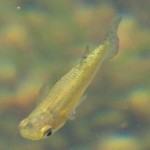
A new study by the U.S. Geological Survey (USGS) suggests that anticipated increases in urban land use in the Piedmont region of the southeastern United States will lead to loss of sensitive fish and invertebrate species from thousands of miles of small streams.
The study’s findings and associated ecological models provide information and projections that can help city and state land managers develop strategies to lessen the adverse effects of current and projected urban development.
The study finds that current levels of urbanization in the region, primarily in areas surrounding Atlanta, Charlotte, Raleigh/Durham, and the Virginia suburbs of Washington, D.C., have already contributed to substantial losses of sensitive aquatic species.
Urban land use in the region is projected to nearly triple by 2060, which could result in loss of more than one-half of sensitive fish species, such as the Lipstick darter and Blue Ridge sculpin, from about 8,600 additional miles of streams.
One-half of sensitive invertebrate species, like certain species of mayflies, stoneflies and caddisflies, could be lost from about 17,000 additional miles of streams.
Pesticide use, decreased dissolved oxygen, phosphorus from fertilizers and streamflow alteration associated with urban activities were identified as likely causes of species loss.
Uncertainties regarding these projections include difficulty predicting future urban development patterns and future changes in pesticide use, land-use strategies, and other stressors that could increase or lessen the impacts on stream quality.
Further studies that track these changes through time could provide a basis for verifying these projections and refining the understanding of relations between urban stressors and stream health.
source: U.S. Geological Survey